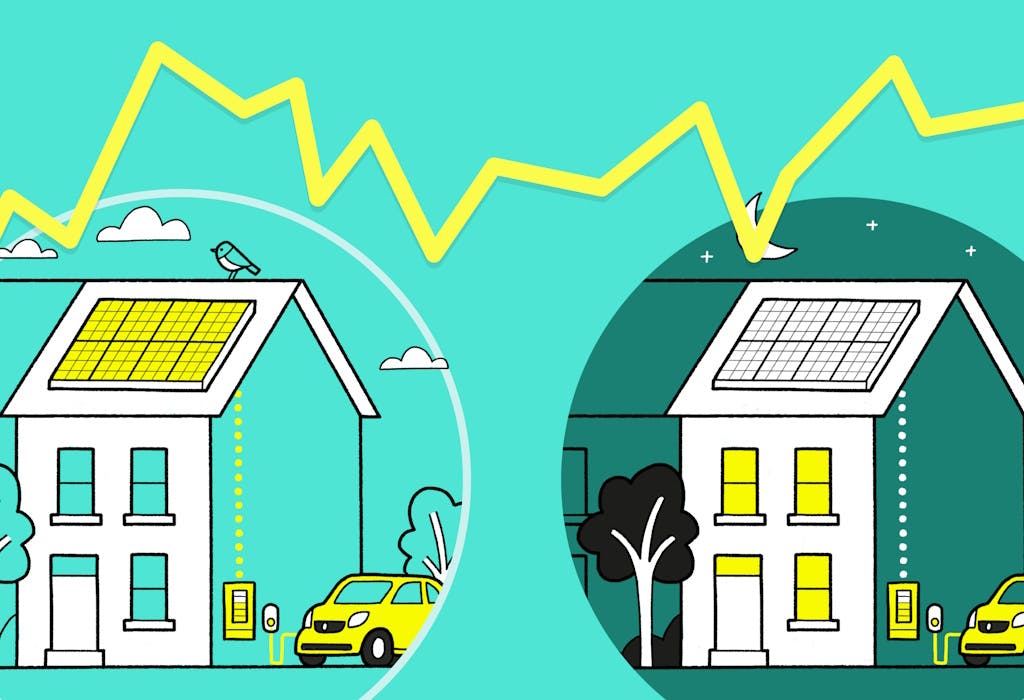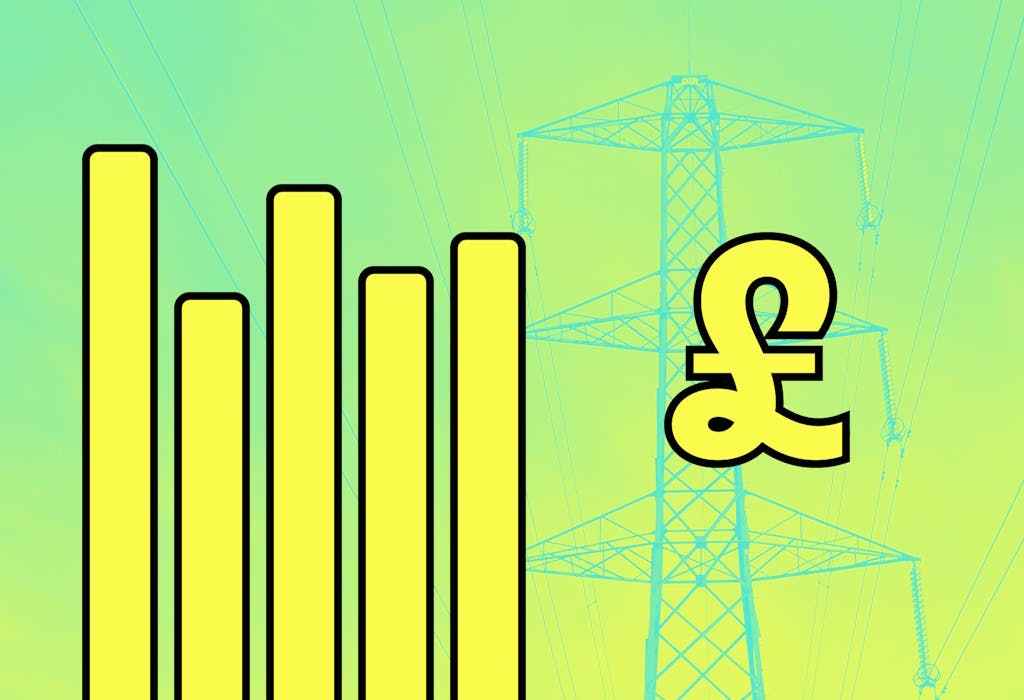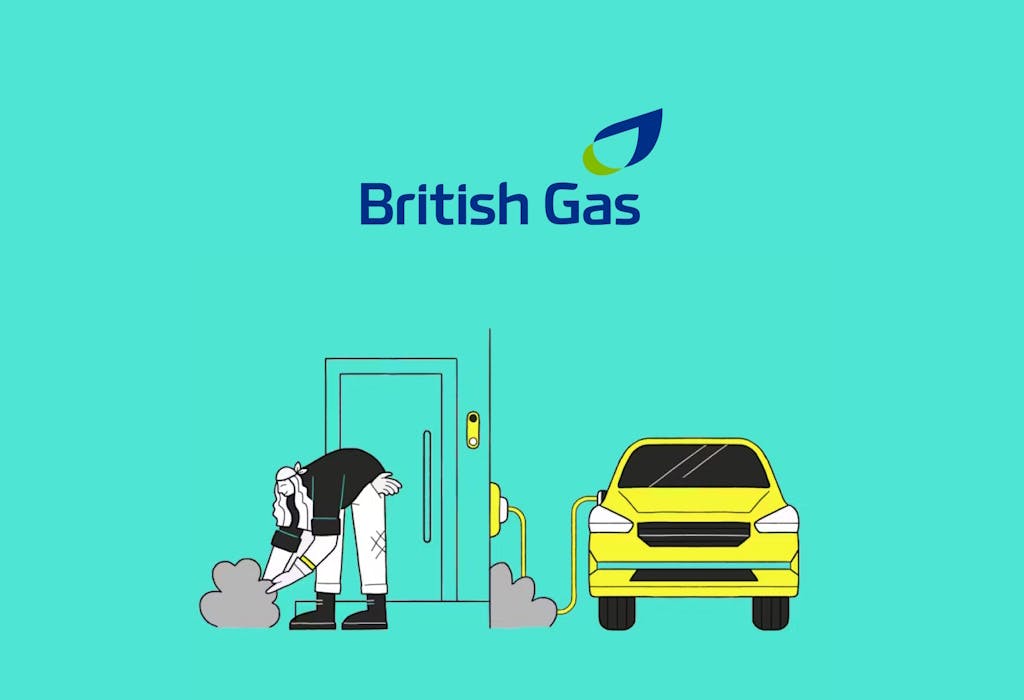- Solar advice hub
- Exporting-to-the-grid
- The 9 best EV charging tariffs
The 9 best EV charging tariffs
Here are all the top EV charging tariffs, how to sign up for them, and which tariffs are best for different households.


Why you can trust our content
We know that the solar industry is full of misinformation, but we only use reliable sources, including:
- Our experienced solar experts, installers and system designers
- Our own database of solar & battery system designs
- Authoritative bodies like MCS and the UK government




Calculate savings
What kind of home do you live in?
Calculate savings
What kind of home do you live in?
The best EV charging tariffs: at a glance
As EV sales have accelerated in the UK, all the major energy suppliers have launched EV charging tariffs, in an attempt to capture this growing customer base.
Their main strategy is to offer a low off-peak rate for drivers who charge their car overnight, allowing you to save hundreds of pounds per year by filling your EV with cheap electricity.
In this article, we’ll run through all the top EV charging tariffs, how to sign up for them, and which tariffs are best for different households.
Some EV tariffs don't actually require you to have an EV, making them a great choice for homes with a solar & battery system (as we'll explain).
And to find out how much you could save by going solar, enter a few details below and we'll provide an estimate.
What are the best EV charging tariffs?
The best EV charging tariffs are Fuse Energy Smart EV, So Energy So EV, and Good Energy EV Charge.
To save as much money as you can, you should consider each tariff’s off-peak rate and hours, peak rate, standing charge, and any other conditions – including exit fees.
We’ll continue to update this list regularly, since energy companies tweak their tariffs so often.
There are now more than 1.6 million fully electric vehicles in the UK, which represents a 307% rise since the end of 2021, and has naturally led to an uptick in home charging.
| Provider | Tariff | Off-peak rate (p/kWh) | Time period | Peak rate (p/kWh) | Daily standing charge (p/day) | Total annual savings* |
|---|---|---|---|---|---|---|
| Fuse Energy | Smart EV | 5 | 5 hours (between 9pm & 7am)** | 27.82 | 46.23 | £638 |
| So Energy | So EV | 6.5 | 12am-5am | 26 | 45.92 | £637 |
| Good Energy | EV Charge | 6.6 |
12am-5am | 29.06 | 43.66 | £577 |
| Utility Warehouse | EV Double Gold | 7 | 12am-5am GMT | 28.695 | 43.701 | £573 |
| British Gas | Electric Driver | 7.9 | 12am-5am | 27.002 | 48.689 | £549 |
| EDF | GoElectric Sep26 | 8.99 | 12am-5am | 26 | 49.74 | £531 |
| Octopus | Intelligent Octopus Go | 7 | 11:30pm-5:30am † | 30.51 | 45.42 | £517 |
| Ecotricity | Smart 1 Year Fixed Green Electricity EV V25.1 | 7.99 | 12am-5am GMT | 31.26 | 41.43 | £498 |
| Octopus | Octopus Go | 8.5 | 12:30am-5:30am | 30.51 | 45.42 | £470 |
The best EV charging tariffs: explained
Here’s all the information you need about the top nine EV charging tariffs, including eligibility criteria, how to sign up, and exit fees.
We’ll also tell you which suppliers are charging high peak rates alongside their low off-peak rates.
You may have to switch electricity suppliers to take advantage of these rates – and it’s usually worth it, considering you could save hundreds of pounds per year as a result.
1. Fuse Energy Smart EV
Fuse provides the lowest off-peak rate on the market, as well as one of the best peak rates around.
This allows Smart EV to top the charts, though with a major downside: you'll never know exactly when the 5p per kWh off-peak period is.
It'll always happen for five hours between 9pm and 7am, but Fuse changes the times every day. The company passes this information through your smart meter to your EV charger – without telling you.
So if you're looking to boost your savings by using your dishwasher or washing machine during the off-peak period, you'll have to be lucky.
Full tariff profile
| Category | Information |
|---|---|
| Off-peak rate (p/kWh) | 5 |
| Time period | Five hours between 9pm & 7am** |
| Peak rate (p/kWh) | 27.82 |
| Standing charge (p/day) | 46.23 |
| Total annual savings* | £638 |
| Exit fee | N/A |
How to switch to Fuse Energy Smart EV
To switch to Smart EV, you'll first need to sign up for one of Fuse's other import tariffs.
As soon as Fuse has connected to your smart meter and EV charger, you'll be able to start using Smart EV instead.
Your EV charger must be made by one of the following manufacturers to qualify:
2. So Energy So EV
This tariff, introduced by So Energy in July 2025, missed out on the top spot by a whisker.
Its 6.5p per kWh off-peak rate is the second-best available, and its 26p per kWh peak rate is the joint-best with EDF's latest GoElectric tariff.
It's only just higher than the July 2025 price cap, which is impressively generous.
A low off-peak rate is usually accompanied by a high peak rate, as suppliers seek to ensure they still extract a good amount of profit.
The pressure to choose a high peak rate only increases when the tariff is designed for households to consume at least 35kWh of electricity per day on the off-peak rate.
That's around four times as much as the 9.3kWh per day used by the average UK household, according to government data.
And unlike Fuse's offering, this tariff's off-peak period happens at the same time every day.
Full tariff profile
| Category | Information |
|---|---|
| Off-peak rate (p/kWh) | 6.5 |
| Time period | 12am-5am |
| Peak rate (p/kWh) | 26 |
| Standing charge (p/day) | 45.92 |
| Total annual savings* | £637 |
| Exit fee | N/A |
How to switch to So Energy So EV
To sign up for So EV, you'll need an electric or plug-in hybrid vehicle that's registered in the UK, as well as a functioning smart meter.
You'll have to switch to the supplier's So Flex tariff at first.
Once that's gone through, you'll be able to move to So EV pretty much straight away, using the supplier's app.
3. Good Energy EV Charge
This is the best EV tariff for homes that don't have an EV.
EV Charge is one of two options on this list for households that are looking to charge their storage battery with cheap, off-peak electricity, then use it to power their home.
If you have solar panels as well, this frees you up to benefit by selling most of the electricity your panels generate, especially if you use one of the best export tariffs around.
EV Charge comes with a relatively high peak rate, but also has the second-lowest standing charge on the list.
However, unlike any other supplier in our top five, Good Energy has attached an exit fee to its tariff, with early leavers paying a sizeable £75.
If you're sure though, lock this tariff in while you can. The provider has repeatedly changed its off-peak rate over the past few months, from 6.75p up to 8p per kWh, then down to 6.6p per kWh.
Full tariff profile
| Category | Information |
|---|---|
| Off-peak rate (p/kWh) | 6.6 |
| Time period | 12am-5am |
| Peak rate (p/kWh) | 29.06 |
| Standing charge (p/day) | 43.66 |
| Total annual savings* | £577 |
| Exit fee | £75 |
How to switch to Good Energy EV Charge
You'll need a smart meter to sign up for EV Charge, but that's about it.
If you're switching from another supplier, Good Energy requires you to join its standard variable tariff first – a process that should usually take two days, according to the provider.
You can do this online or over the phone, and will need to set up a direct debit.
Good Energy will then spend up to two weeks setting up the connection to your smart meter, at which point the supplier will transfer you seamlessly to EV Charge.
You'll get an email telling you when the switch is complete, and how to access the free Zapmap Premium subscription that comes with EV Charge.
You shouldn't need this subscription though, assuming you only charge at home with cheap, off-peak electricity.
4. Utility Warehouse EV Double Gold
Utility Warehouse combines an attractive 7p per kWh off-peak rate with a decent standing charge to create this top-tier EV tariff – but there is a catch.
You can only qualify for Double Gold if you receive at least three services from Utility Warehouse.
That includes energy – which you’ll tick off with this tariff – so you’ll have to switch to the provider for two of the following three utilities: wifi, mobile, and boiler and home cover.
Otherwise, it's a fine tariff, with a peak rate of 28.695p per kWh that's almost exactly average for this list, and a standing charge that's better than most.
Look out for the clocks changing, though. This is a GMT-based tariff, so during British Summer Time – which lasts for most of the year – the off-peak rate will be active from 1am to 6am.
Full tariff profile
| Category | Information |
|---|---|
| Off-peak rate (p/kWh) | 7 |
| Time period | 12am-5am GMT |
| Peak rate (p/kWh) | 28.695 |
| Standing charge (p/day) | 43.701 |
| Total annual savings* | £573 |
| Exit fee | N/A |
How to switch to Utility Warehouse EV Double Gold
As mentioned above, you’ll need to switch to Utility Warehouse for any two of your wifi, mobile, or boiler and home cover before you can qualify.
Once you’ve made it through that process, switch to the supplier’s standard variable tariff, and answer yes when you’re asked whether you’d like to join an EV tariff.
As soon as you’re receiving your electricity from Utility Warehouse, the company will invite you to switch.
You’ll just need a smart meter, your EV’s registration number, the ability to set up a direct debit, and at least one EV that’s up to date on its vehicle tax and has a valid MOT certificate.
You can put up to three EVs from the same property on this tariff.
5. British Gas Electric Driver
This is the second tariff on our list that doesn’t require households to have an electric car to qualify, after Good Energy EV Charge.
This allows homes with a solar & battery system to save money by charging their battery on the overnight off-peak rate, then using that electricity to power their home during the day.
British Gas’s 7.9p per kWh off-peak rate is slightly higher than average for this list, but its peak rate is the third-lowest. All its rates are fixed for 13 months from when you start.
Full tariff profile
| Category | Information |
|---|---|
| Off-peak rate (p/kWh) | 7.9 |
| Time period | 12am-5am |
| Peak rate (p/kWh) | 27.002 |
| Standing charge (p/day) | 48.689 |
| Total annual savings* | £549 |
| Exit fee | N/A |
How to switch to British Gas Electric Driver
You can switch to this tariff with a smart meter and the ability to set up a direct debit.
You don’t need an EV, an EV charger, or any other hardware.
If you meet these eligibility criteria and you’re already receiving your electricity from British Gas, you can make the move straight away by logging into your account.
Everyone else can switch to Electric Driver by getting a quote online, then filling in the form that pops up, which asks for standard information like your household, contact, and payment details.
Then just accept the terms and conditions, and you should be switched over within three weeks.
For more information, read our full guide to British Gas Electric Driver.
6. EDF GoElectric Sep26
This tariff, which comes with the highest off-peak rate and standing charge on our list, is saved by its peak rate.
26p per kWh is only slightly above the July 2025 price cap, and just like So Energy So EV customers, households on GoElectric can benefit enormously from this rate.
Unfortunately, that's where the generosity stops, with EDF imposing a £75 exit fee on this tariff.
It's by far EDF's best offering, though. The supplier's EVolve Tracker tariff comes with a high 16.01p per kWh off-peak rate, while its Pod Point Plug & Power tariff includes a shockingly priced £1.29 daily standing charge.
Full tariff profile
| Category | Information |
|---|---|
| Off-peak rate (p/kWh) | 8.99 |
| Time period | 12am-5am |
| Peak rate (p/kWh) | 26 |
| Standing charge (p/day) | 49.74 |
| Total annual savings* | £531 |
| Exit fee | £75 |
How to switch to EDF GoElectric Sep26
If you currently receive your electricity from a different supplier, the first step is to switch to EDF's standard variable tariff, which you can do online.
Once you've completed the move, EDF will start signing you up for GoElectric, which should take just a few days.
As ever, you'll need a smart meter and the capacity to set up a direct debit.

7. Intelligent Octopus Go
Intelligent Octopus Go offers six hours of cheap charging per day from 11:30pm to 5:30am, making it the longest off-peak period on this list, but with a difference: it’s smart.
That means whenever the grid has a surplus of electricity, Octopus will provide extra off-peak times.
So as well as the fixed 11:30pm-5:30am period, you’ll find out every day at 4pm whether the next day will contain additional off-peak hours to charge your car and power your home for 7p per kWh.
Unfortunately, this tariff is currently only available to certain chargers and EVs, which is its major drawback.
Intelligent Octopus Go comes as a fixed or variable tariff – but its off-peak rate is unlikely to change much, considering it's only shifted once since it launched in 2022, from 7.5p to 7p per kWh.
It does also come with a £25 exit fee now, which is at least below average for this list.
Full tariff profile
| Category | Information |
|---|---|
| Off-peak rate (p/kWh) | 7 |
| Time period | 11:30pm-5:30am (plus extra hours) |
| Peak rate (p/kWh) | 30.51 |
| Standing charge (p/day) | 45.42 |
| Total annual savings* | £517 |
| Exit fee | £25 |
How to switch to Intelligent Octopus Go
Intelligent Octopus Go is only open to some chargers and EVs. There’s no publicly available list, but you can check your compatibility using Octopus’s tool.
Our research has shown that most chargers made by Hypervolt, Indra, Myenergi, Ohme, and Wallbox are eligible for the tariff, but this isn’t necessarily an exhaustive list.
Plenty of cars can also help you qualify, including models made by Audi, BMW, Ford, Toyota, and Volkswagen.
As long as you have an eligible EV and charger, all you’ll need to sign up is a smart meter and an Apple or Android device, so you can set your car’s charging schedule.
If you’re already getting your grid electricity from Octopus, you can quickly make the switch in your Octopus app.
If not, you’ll just have to register for a standard Octopus tariff – which should take no more than three weeks – then move to Intelligent Octopus Go.
Once that’s done, just use the app to agree to the terms and conditions, complete a test charge, and you’ll be completely set up.
8. Ecotricity Smart 1 Year Fixed Green Electricity EV
Ecotricity’s offering is a mixed bag.
Its off-peak rate is the third-highest on this list, and its peak rate is the highest – but its standing charge is way lower than those offered by competitors.
By paying 41.43p every day instead of the average rate you can find from suppliers on this list – 45.58p per day – a household can save £15 per year.
It's hard to look past a 31.26p per kWh peak rate, though. It's the most expensive rate in this article, and sits well above the average of 28.54p per kWh. You could therefore end up paying less to charge your car, but more to power your home.
And if you leave the tariff early, you’ll pay a £100 exit fee, which is the highest of all the EV tariffs. In fact, most companies won’t even charge you for switching.
The 7.99p per kWh off-peak rate is also only available in London, but it’s roughly indicative, since you’ll pay between 7.75p and 8.44p per kWh wherever you are in the country.
Full tariff profile
| Category | Information |
|---|---|
| Off-peak rate (p/kWh) | 7.99 |
| Time period | 12am-5am GMT |
| Peak rate (p/kWh) | 31.26 |
| Standing charge (p/day) | 41.43 |
| Total annual savings* | £498 |
| Exit fee | £100 |
How to switch to Ecotricity Smart 1 Year Fixed Green Electricity EV
To switch to this tariff, you need an EV, a charger, and a smart meter.
You’ll also need to pay by monthly direct debit.
To start the process, you can apply online or by calling 08081 230 123.
You may need to provide proof that you own an EV charger at home, but generally the whole undertaking should be relatively smooth.
9. Octopus Go
This tariff is the inferior version of Intelligent Octopus Go, though with one shining light: you can qualify for Octopus Go with any charger or EV.
It's worse in most other ways. Its off-peak period is shorter and comes with a higher 8.5p per kWh rate, and it doesn't offer the extra off-peak hours that come with Intelligent Octopus Go.
The two Octopus tariffs share the same peak rate – which is the second-highest on this list – and the same, middling standing charge.
Full tariff profile
| Category | Information |
|---|---|
| Off-peak rate (p/kWh) | 8.5 |
| Time period | 12:30am-5:30am |
| Peak rate (p/kWh) | 30.51 |
| Standing charge (p/day) | 45.42 |
| Total annual savings* | £470 |
| Exit fee | £25 |
How to switch to Octopus Go
To switch to Octopus Go, you'll need to have an EV, a charger, and a smart meter.
The first step is to sign up to one of Octopus's standard tariffs, after which point the supplier will take around 14 days to connect to your smart meter.
Octopus will then email you with confirmation that you're connected, and asking you to accept the EV tariff's terms and conditions.
Once you do, you'll switch to Octopus Go straight away.
Summary
The best EV charging tariff depends on your household, though it’s currently likely to be Fuse Energy Smart EV, So Energy So EV, or Good Energy EV Charge.
Whether you have an EV, a solar & battery system, or both, it’s absolutely worth seeing if an EV tariff could cut your electricity bills.
Making this switch will usually save you hundreds of pounds per year, which makes it much more affordable to have an EV, and substantially increases your returns from going solar.
And if you’re wondering how much you could save with a solar & battery system, enter a few details below and we’ll provide an estimate.
The best EV tariffs: FAQs
Related articles

Written byJosh Jackman
Josh has written about the rapid rise of home solar for the past six years. His data-driven work has been featured in United Nations and World Health Organisation documents, as well as publications including The Eco Experts, Financial Times, The Independent, The Telegraph, The Times, and The Sun. Josh has also been interviewed as a renewables expert on BBC One’s Rip-Off Britain, ITV1’s Tonight show, and BBC Radio 4 and 5.



